暴力匹配及KMP算法解决字符串匹配
威斯布鲁克.猩猩 人气:0要解决的问题?

一、暴力匹配算法
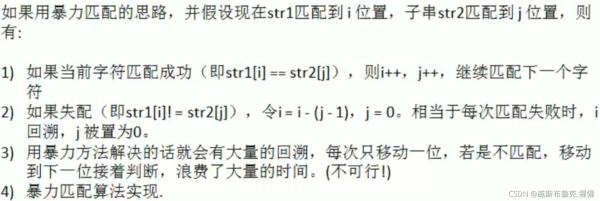
一个图例介绍KMP算法
String str1 = "BBC ABCDAB ABCDABCDABDE"; String str2 = "ABCDABD";
1. S[0]为B,P[0]为A,不匹配,执行第②条指令:“如果失配(即S[i]! = P[j]),令i = i - (j - 1),j = 0”,S[1]跟P[0]匹配,相当于模式串要往右移动一位(i=1,j=0)

2. S[1]跟P[0]还是不匹配,继续执行第②条指令:“如果失配(即S[i]! = P[j]),令i = i - (j - 1),j = 0”,S[2]跟P[0]匹配(i=2,j=0),从而模式串不断的向右移动一位(不断的执行“令i = i - (j - 1),j = 0”,i从2变到4,j一直为0)

3. 直到S[4]跟P[0]匹配成功(i=4,j=0),此时按照上面的暴力匹配算法的思路,转而执行第①条指令:“如果当前字符匹配成功(即S[i] == P[j]),则i++,j++”,可得S[i]为S[5],P[j]为P[1],即接下来S[5]跟P[1]匹配(i=5,j=1)

4. S[5]跟P[1]匹配成功,继续执行第①条指令:“如果当前字符匹配成功(即S[i] == P[j]),则i++,j++”,得到S[6]跟P[2]匹配(i=6,j=2),如此进行下去

5. 直到S[10]为空格字符,P[6]为字符D(i=10,j=6),因为不匹配,重新执行第②条指令:“如果失配(即S[i]! = P[j]),令i = i - (j - 1),j = 0”,相当于S[5]跟P[0]匹配(i=5,j=0)

6. 至此,我们可以看到,如果按照暴力匹配算法的思路,尽管之前文本串和模式串已经分别匹配到了S[9]、P[5],但因为S[10]跟P[6]不匹配,所以文本串回溯到S[5],模式串回溯到P[0],从而让S[5]跟P[0]匹配。

而S[5]肯定跟P[0]失配。为什么呢?因为在之前第4步匹配中,我们已经得知S[5] = P[1] = B,而P[0] = A,即P[1] != P[0],故S[5]必定不等于P[0],所以回溯过去必然会导致失配。那有没有一种算法,让i 不往回退,只需要移动j 即可呢?
答案是肯定的。这种算法就是KMP算法,它利用之前已经部分匹配这个有效信息,保持i 不回溯,通过修改j 的位置,让模式串尽量地移动到有效的位置。
public class ViolenceMatch {
public static void main(String[] args) {
String str1 = "硅硅谷 尚硅谷你尚硅 尚硅谷你尚硅谷你尚硅你好";
String str2 = "尚硅谷你尚硅你";
int index = violenceMatch(str1, str2);
System.out.println("index=" + index);
}
/**
* 暴力匹配算法
*/
public static int violenceMatch(String str1, String str2) {
char[] s1 = str1.toCharArray();
char[] s2 = str2.toCharArray();
int s1Len = s1.length;
int s2Len = s2.length;
int i = 0;// i索引指向s1
int j = 0;// j索引指向s2
while (i < s1Len && j < s2Len) {// 保证匹配时,不越界
if (s1[i] == s2[j]) {// 匹配ok
i++;
j++;
} else {// 没有匹配成功
// 如果不匹配(即str1[i] != str2[j],令i = i - (j - 1),j = 0)
i = i - (j - 1);
j = 0;
}
}
// 判断是否匹配成功
if (j == s2Len) {
return i - j;
} else {
return -1;
}
}
}
暴力匹配算法的缺点:大量数据使用暴力匹配效率很低
二、KMP算法
关于KMP算法的学习,参考了这篇文章,此博主写的特别详细,大佬!
参考链接:https://www.cnblogs.com/zzuuoo666/p/9028287.html
算法介绍

KMP的主要思想是:1. 先得到子串的部分匹配表 2.使用部分匹配表完成KMP匹配
一个图例介绍KMP算法






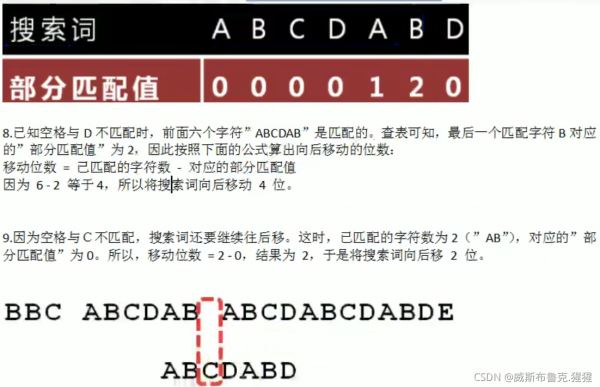

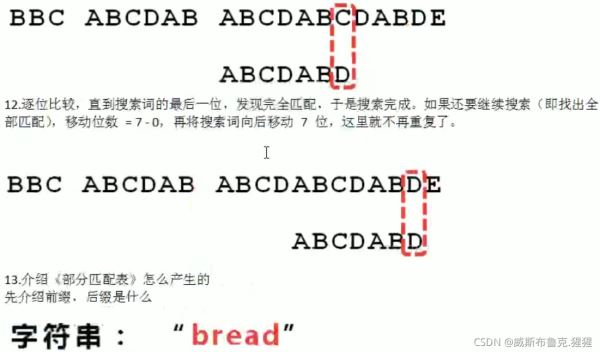

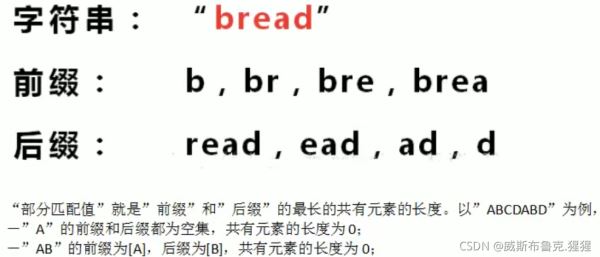
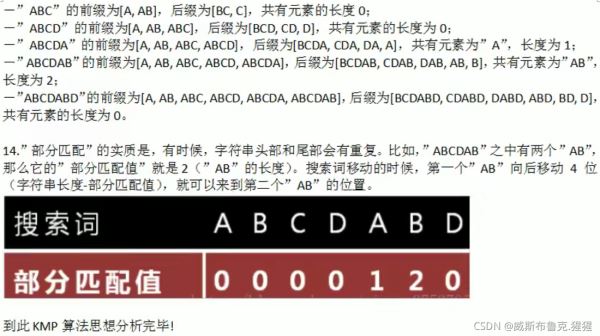
代码实现
public class KMPAlgorithm {
public static void main(String[] args) {
String str1 = "BBC ABCDAB ABCDABCDABDE";
String str2 = "ABCDABD";
int[] next = kmpNext("ABCDABD");
System.out.println("next=" + Arrays.toString(next));
int index = kmpSearch(str1, str2, next);
System.out.println("index=" + index);
}
/**
* kmp搜索算法
*
* @param str1 原字符串
* @param str2 子串
* @param next 部分匹配表,是子串对应的部分匹配表
* @return 如果是-1就是没有匹配到,否则返回第一个匹配的位置
*/
public static int kmpSearch(String str1, String str2, int[] next) {
// 遍历
for (int i = 0, j = 0; i < str1.length(); i++) {
// 需要处理 str1.charAt(i) != str2.charAt(j),去调整j的大小
// KMP算法核心点
while (j > 0 && str1.charAt(i) != str2.charAt(j)) {
j = next[j - 1];
}
if (str1.charAt(i) == str2.charAt(j)) {
j++;
}
if (j == str2.length()) {// 找到了
return i - j + 1;
}
}
return -1;
}
/**
* 获取到一个字符串(子串)的部分匹配值表
*/
public static int[] kmpNext(String dest) {
// 创建一个next数组保存部分匹配值
int[] next = new int[dest.length()];
next[0] = 0;// 如果字符串是长度为1部分匹配值就是0
for (int i = 1, j = 0; i < dest.length(); i++) {
// 当dest.charAt(i) != dest.charAt(j),需要从next[j - 1]获取新的j
// 直到发现有dest.charAt(i) == dest.charAt(j)成立才退出
// 这是kmp算法核心点
while (j > 0 && dest.charAt(i) != dest.charAt(j)) {
j = next[j - 1];
}
if (dest.charAt(i) == dest.charAt(j)) {
j++;
}
next[i] = j;
}
return next;
}
}
加载全部内容